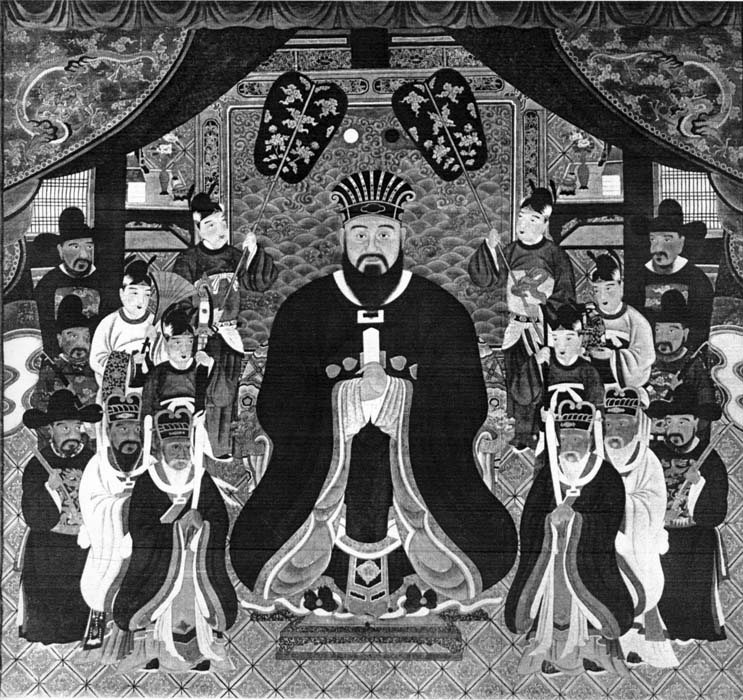|
Kong Young Il
Kong Young-il (born 1943) is a South Korean master of taekwondo and one of the twelve original masters of taekwondo of the Korea Taekwon-Do Association.Choi, H. H. (1972): ''Taekwon-Do: The Korean art of self-defence''. Mississauga: International Taekwon-Do Federation.Park, S. H. (1993): "About the author." In H. H. Choi: ''Taekwon-Do: The Korean art of self-defence'', 3rd ed. (Vol. 1, pp. 241–274). Mississauga: International Taekwon-Do Federation.A tribute to the original masters (c. 2007). Retrieved on 13 June 2007; link has expired, as at 1 July 2011. He holds the rank of 9th '' dan''.Anslow, S. (2004) [...More Info...] [...Related Items...] OR: [Wikipedia] [Google] [Baidu] |
Kong (Korean Name)
Kong may refer to: Places * Kong Empire (1710–1895), a former African state covering north-eastern Côte d'Ivoire and much of Burkina Faso * Kong, Iran, a city on the Persian Gulf * Kong, Shandong (), a town in Laoling, Shandong, China * Kong, Ivory Coast, a town in Savanes District, Ivory Coast * Kong River, in Southeast Asia * Koh Kong (island), island in the Gulf of Thailand, in the coastal waters of Cambodia Arts and entertainment Fictional characters * King Kong, a giant ape appearing in several films and other works * ''Donkey Kong'', a series of video games that feature various ape characters that use the Kong name ** Donkey Kong (character) ** Diddy Kong, Donkey Kong's partner * Major T. J. "King" Kong, in the 1964 film ''Dr. Strangelove'' * the title caveman character of '' Kong the Untamed'', a 1975 comic book series * Giant Robots Kongs, various characters from the ''Dai Sentai Goggle-V'' series * Jake Kong, one of the three main characters from the original '' The G ... [...More Info...] [...Related Items...] OR: [Wikipedia] [Google] [Baidu] |
Karate
(; ; Okinawan language, Okinawan pronunciation: ), also , is a martial arts, martial art developed in the Ryukyu Kingdom. It developed from the Okinawan martial arts, indigenous Ryukyuan martial arts (called , "hand"; ''tī'' in Okinawan) under the influence of Chinese martial arts. While modern karate is primarily a striking art that uses punches and kicks, traditional karate training also employs Throw (grappling), throwing and joint locking techniques. A karate practitioner is called a . Beginning in the 1300s, early Chinese martial arts, Chinese martial artists brought their techniques to Okinawa. Despite the Ryukyu Kingdom being turned into a puppet state by Japanese samurai in 1609, after the Invasion of Ryukyu, its cultural ties to China remained strong. Since Ryukyuans were banned from carrying swords under samurai rule, groups of young aristocrats created unarmed combat methods as a form of resistance, combining Chinese and local styles of martial arts. Training emph ... [...More Info...] [...Related Items...] OR: [Wikipedia] [Google] [Baidu] |
People From The Las Vegas Valley
The term "the people" refers to the public or common mass of people of a polity. As such it is a concept of human rights law, international law as well as constitutional law, particularly used for claims of popular sovereignty. In contrast, a people is any plurality of persons considered as a whole. Used in politics and law, the term "a people" refers to the collective or community of an ethnic group or nation. Concepts Legal Chapter One, Article One of the Charter of the United Nations states that "peoples" have the right to self-determination. Though the mere status as peoples and the right to self-determination, as for example in the case of Indigenous peoples (''peoples'', as in all groups of indigenous people, not merely all indigenous persons as in ''indigenous people''), does not automatically provide for independent sovereignty and therefore secession. Indeed, judge Ivor Jennings identified the inherent problems in the right of "peoples" to self-determination, as i ... [...More Info...] [...Related Items...] OR: [Wikipedia] [Google] [Baidu] |
Martial Arts School Founders
Marcus Valerius Martialis (known in English as Martial ; March, between 38 and 41 AD – between 102 and 104 AD) was a Roman and Celtiberian poet born in Bilbilis, Hispania (modern Spain) best known for his twelve books of ''Epigrams'', published in Ancient Rome, Rome between AD 86 and 103, during the reigns of the emperors Domitian, Nerva and Trajan. In these poems he satirises city life and the scandalous activities of his acquaintances, and romanticises his provincial upbringing. He wrote a total of 1,561 epigrams, of which 1,235 are in elegiac couplets. Martial has been called the greatest Latin epigrammatist, and is considered the creator of the modern epigram. He also coined the term plagiarism. Early life Knowledge of his origins and early life are derived almost entirely from his works, which can be more or less dated according to the well-known events to which they refer. In Book X of his ''Epigrams'', composed between 95 and 98, he mentions celebrating his fift ... [...More Info...] [...Related Items...] OR: [Wikipedia] [Google] [Baidu] |
1943 Births
Events Below, the events of World War II have the "WWII" prefix. January * January 1 – WWII: The Soviet Union announces that 22 German divisions have been encircled at Stalingrad, with 175,000 killed and 137,650 captured. * January 4 – WWII: Greek-Polish athlete and saboteur Jerzy Iwanow-Szajnowicz is executed by the Germans at Kaisariani. * January 10 – WWII: Guadalcanal campaign, Guadalcanal Campaign: American forces of the 2nd Marine Division and the 25th Infantry Division (United States), 25th Infantry Division begin their assaults on the Battle of Mount Austen, the Galloping Horse, and the Sea Horse#Galloping Horse, Galloping Horse and Sea Horse on Guadalcanal. Meanwhile, the Japanese Seventeenth Army (Japan), 17th Army makes plans to abandon the island and after fierce resistance withdraws to the west coast of Guadalcanal. * January 11 ** The United States and United Kingdom revise previously unequal treaty relationships with the Republic of China (1912–194 ... [...More Info...] [...Related Items...] OR: [Wikipedia] [Google] [Baidu] |
Living People
Purpose: Because living persons may suffer personal harm from inappropriate information, we should watch their articles carefully. By adding an article to this category, it marks them with a notice about sources whenever someone tries to edit them, to remind them of WP:BLP (biographies of living persons) policy that these articles must maintain a neutral point of view, maintain factual accuracy, and be properly sourced. Recent changes to these articles are listed on Special:RecentChangesLinked/Living people. Organization: This category should not be sub-categorized. Entries are generally sorted by family name In many societies, a surname, family name, or last name is the mostly hereditary portion of one's personal name that indicates one's family. It is typically combined with a given name to form the full name of a person, although several give .... Maintenance: Individuals of advanced age (over 90), for whom there has been no new documentation in the last ten ... [...More Info...] [...Related Items...] OR: [Wikipedia] [Google] [Baidu] |
List Of Taekwondo Grandmasters
This list of taekwondo grandmasters includes notable persons who have been recognized as grandmasters of the Korean martial art of taekwondo. There is no single, universally-recognized set of criteria to define a taekwondo grandmaster; different organizations and different styles have their own rules. Those listed below are grouped by system: Kukkiwon (widely known as the World Taekwondo Headquarters), International Taekwon-Do Federation (ITF), and other systems (which includes some persons receiving ranks from taekwondo organizations that predate the other two systems, e.g., the original Korea Taekwondo Association Korea Taekwondo Association (; KTA), originally the Korea Tang Soo Do Association (1961),Park, S. H. (1993): About the author. In H. H. Choi: ''Taekwon-Do: The Korean art of self-defence'', 3rd ed. (Vol. 1, pp. 241–274). Mississauga: Internatio ... (KTA)) and United Taekwondo Association UWTA. World Alliance Taekwon-do Federation GM Francesc Campanya Kukki ... [...More Info...] [...Related Items...] OR: [Wikipedia] [Google] [Baidu] |
International Taekwon-Do Federation
International Taekwon-Do Federation (ITF) is an international taekwondo organization founded on March 22, 1966, by Choi Hong Hi () in Seoul, South Korea. The ITF was founded to promote and encourage the growth of the Korean martial art of taekwon-do. The ITF's main functions include coordinating and approving tournaments and seminars, setting standards for teaching (patterns, sparring, destruction), collaborating with affiliated member organizations, and providing services members in regard to rank and certifications. After Choi's death in 2002, there was controversy around the election of his successor that led to multiple organizations claiming the ITF mantle. Patterns Patterns, or ''tul'' (틀) in Korean, originally called '' hyeong'' (형), form an important aspect of training in taekwon-do. They are equivalent to the ''kata'' in karate. The majority of the patterns (except Yul-Gok, Ul-Ji and Tong-Il) start with a defensive move, which emphasizes taekwon-do's defens ... [...More Info...] [...Related Items...] OR: [Wikipedia] [Google] [Baidu] |
Choi Chang-keun
__NOTOC__ Choi Chang-keun (; born 1941), widely known as C. K. Choi, is a South Korean–Canadian master of taekwondo,Tae Kwon Do Pioneers: Grand Master C. K. Choi Retrieved on 5 January 2010.Park, S. H. (1993): "About the author." In H. H. Choi: ''Taekwon-Do: The Korean art of self-defence'', 3rd ed. (Vol. 1, pp. 241–274). Mississauga: International Taekwon-Do Federation. Retrieved on 5 January 2010.Hawkins, P. (2005) An interview with Grandmaster C. K. Choi ''To ... [...More Info...] [...Related Items...] OR: [Wikipedia] [Google] [Baidu] |
Judo
is an unarmed gendai budō, modern Japanese martial art, combat sport, Olympic sport (since 1964), and the most prominent form of jacket wrestling competed internationally.『日本大百科全書』電子版【柔道】(CD-ROM version of Encyclopedia Nipponica, "Judo"). Judo was created in 1882 by Kanō Jigorō () as an eclectic martial art, distinguishing itself from its predecessors (primarily Tenjin Shin'yō-ryū, Tenjin Shinyo-ryu jujutsu and Kitō-ryū jujutsu) due to an emphasis on "randori" (, lit. 'free sparring') instead of alongside its removal of striking and weapon training elements. Judo rose to prominence for its dominance over Kodokan–Totsuka rivalry, established jujutsu schools in tournaments hosted by the Tokyo Metropolitan Police Department (警視庁武術大会, ''Keishicho Bujutsu Taikai''), resulting in its adoption as the department's primary martial art. A judo practitioner is called a , and the judo uniform is called . The objective of competitive ju ... [...More Info...] [...Related Items...] OR: [Wikipedia] [Google] [Baidu] |
Kyung Hee University
Kyung Hee University (KHU; ) is a Private university, private research university in South Korea with campuses in Seoul and Suwon. It was founded in 1949. Kyung Hee University is part of the Kyung Hee University System, which offers comprehensive education from kindergarten through graduate school. As of 2020, about 33,000 students were enrolled in Kyung Hee University. The university consists of 24 Undergraduate education, undergraduate colleges, 1 general graduate school, 13 specialty graduate schools, and 49 auxiliary research institutions. The university offers a International student, study abroad program in partnership with 434 sister universities in 69 countries. Kyung Hee University is known for its College of Korean Medicine, which is considered a leading school in traditional Korean medicine and other traditional East Asian medical practices. History Kyung Hee University originated in 1949 as Sin Heung Junior College, a Junior college, 2-year college. Amid the financia ... [...More Info...] [...Related Items...] OR: [Wikipedia] [Google] [Baidu] |
Shotokan
is a style of karate, developed from various martial arts by Gichin Funakoshi (1868–1957) and his son Gigo (Yoshitaka) Funakoshi (1906–1945). Gichin Funakoshi was born in Okinawa and is widely credited with popularizing "karate do" through a series of public demonstrations, and by promoting the development of university karate clubs, including those at Keio, Waseda, Hitotsubashi (Shodai), Takushoku, Chuo, Gakushuin, and Hosei. Funakoshi had many students at the university clubs and outside dojos, who continued to teach karate after his death in 1957. However, internal disagreements (in particular the notion that competition is contrary to the essence of karate) led to the creation of different organisations—including an initial split between the Japan Karate Association (headed by Masatoshi Nakayama) and the Shotokai (headed by Motonobu Hironishi and Shigeru Egami), followed by many others—so that today there is no single "Shotokan school", although they a ... [...More Info...] [...Related Items...] OR: [Wikipedia] [Google] [Baidu] |




